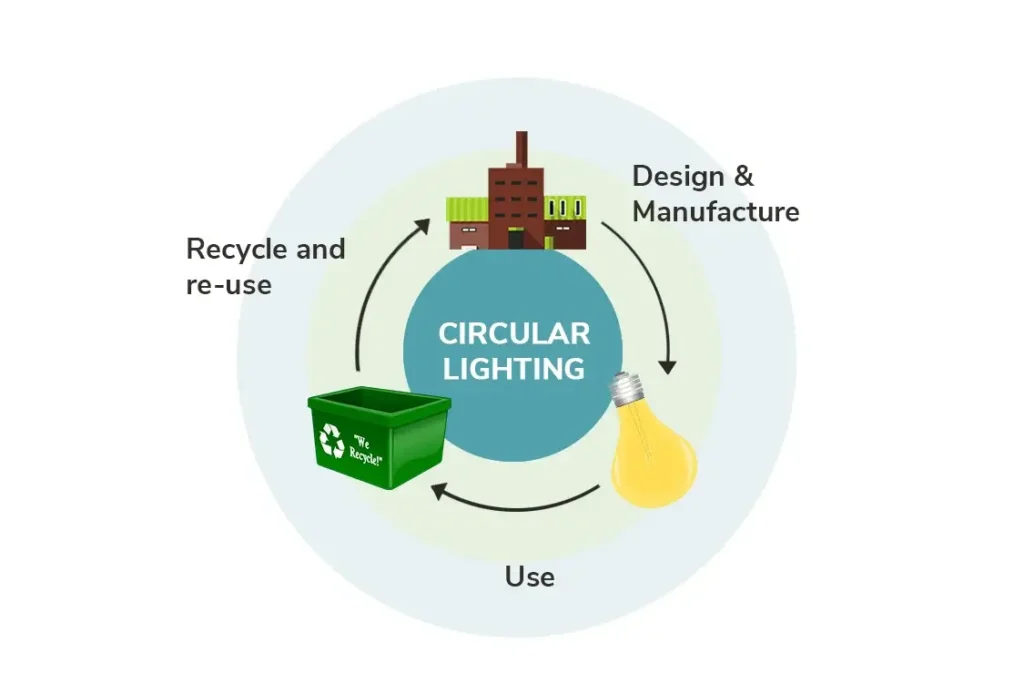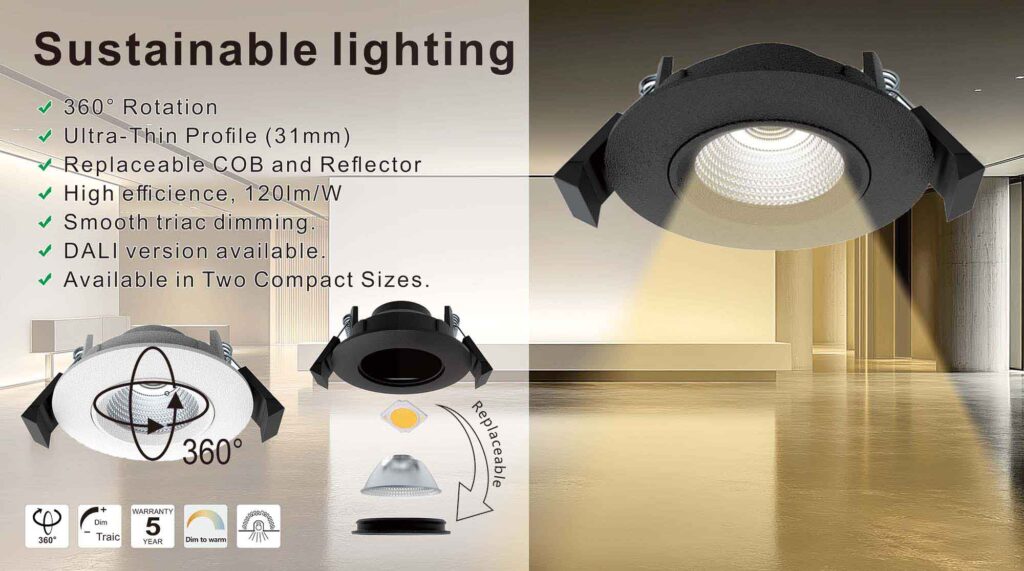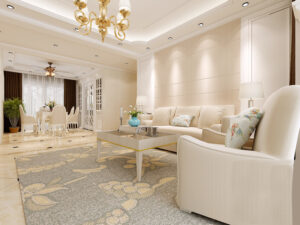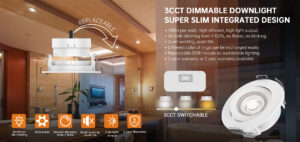The European lighting industry is entering a new era in 2025, shaped by urgent climate goals, stricter regulations, and a growing demand for bæredygtig belysning solutions.
The concept of cirkulær økonomi belysning is at the heart of this transformation, shifting the industry away from the old “take-make-dispose” approach toward a model that prioritizes resource efficiency, product longevity, and responsible end-of-life management.
This shift is not just a matter of environmental responsibility—it is now a legal and market imperative across Germany, the Netherlands, France, Sweden, Denmark, Norway, the United Kingdom, and beyond.
This comprehensive article explores what circular economy lighting means, why it matters, and how leading manufacturers like Radians belysning are driving innovation in this space. We will examine the latest legal requirements, product categories, and practical strategies for implementing circular lighting. You will find detailed comparisons, actionable guidance, and official sources, ensuring you have the knowledge to make informed, future-proof decisions for your projects.
What is Circular Economy Lighting?
Circular economy lighting is an approach to designing, producing, using, and disposing of lighting products that keeps resources in use for as long as possible. Unlike traditional linear models, circular lighting aims to minimize waste and maximize value by focusing on:- Holdbarhed: Products are built to last, reducing the need for frequent replacement.
- Repairability and Modularity: Components can be easily replaced or upgraded.
- Genanvendelighed: Materials are chosen and assembled so they can be efficiently recycled.
- Resource Efficiency: Manufacturing processes minimize waste and energy consumption.
- Take-Back and Refurbishment: Manufacturers offer programs to collect, refurbish, or recycle used products.
- Transparency: Clear information is provided about product composition, energy use, and end-of-life options.

Official Requirements for Sustainable Lighting in Europe
Regulatory Framework Overview
Sustainable lighting in Europe is governed by a robust set of official regulations and standards. These ensure that lighting products are energy-efficient, safe, and environmentally responsible from design through disposal. The most important requirements include:1. Ecodesign Directive (2009/125/EC)
De Direktivet om miljøvenligt design sets minimum requirements for the environmental performance of energy-related products. For lighting, this means:- Higher minimum efficacy for LED and other lighting products.
- Mandatory modularity: Key components (like LEDs and drivers) must be replaceable.
- Restrictions on hazardous substances such as mercury.
- End-of-life instructions: Manufacturers must provide clear guidance for disposal and recycling.
2. Energy Labelling Regulation (EU) 2019/2015
De Energy Labelling Regulation requires all lighting products to display a standardized energy label. This label shows the energy efficiency class (A-G), annual energy consumption, and other key performance data.3. Waste Electrical and Electronic Equipment (WEEE) Directive (2012/19/EU)
De WEEE-direktivet obliges manufacturers and importers to organize take-back and recycling schemes for end-of-life lighting products. Producers must register with national WEEE schemes, provide free collection points, and report recycling rates.4. Restriction of Hazardous Substances (RoHS) Directive (2011/65/EU)
De RoHS Directive limits the use of hazardous substances in electrical and electronic equipment, including lighting. Strict limits are set for mercury, lead, cadmium, and other chemicals.5. Circular Economy Action Plan
De EU Circular Economy Action Plan requires products to be designed for disassembly, material transparency, and extended producer responsibility.6. National Implementation
Each country adapts these directives to its own market. For example:- Tyskland: Strong enforcement of WEEE and RoHS, plus incentives for energy-efficient retrofits.
- Frankrig: Eco-labeling and extended producer responsibility schemes.
- Sweden, Denmark: High standards for recyclability and low environmental impact in public procurement.
- Storbritannien: Maintains alignment with EU standards post-Brexit, with added focus on circularity.
7. Industry Standards and Voluntary Labels
- ENEC Mark: European safety and performance compliance.
- EU Ecolabel: For products with low environmental impact.
- LightingEurope Guidelines: Best practices for circular design and energy efficiency (LightingEurope).
Summary Table: Key Official Requirements
| Krav | Directive/Standard | Key Points | Official Source |
|---|---|---|---|
| Energieffektivitet | Ecodesign, Energy Labelling | Minimum efficacy, energy label, lifetime info | EU Ecodesign |
| Product Modularity & Reparability | Ecodesign, Circular Economy | Replaceable parts, design for disassembly | EU Circular Economy |
| Hazardous Substance Restriction | RoHS Directive | Limits on mercury, lead, cadmium | EU RoHS |
| End-of-Life Management | WEEE-direktivet | Take-back schemes, recycling, producer responsibility | EU WEEE |
| Environmental Transparency | Energy Labelling, Ecolabel | Clear product info, material disclosure, eco-labels | EU Ecolabel |
The Environmental Impact of Lighting
Lighting represents nearly 15% of global electricity use and a significant share of greenhouse gas emissions. The transition to LED technology has already reduced energy consumption, but the environmental impact extends beyond just power usage. Traditional lighting often contains hazardous materials and is difficult to recycle, leading to landfill waste and pollution. Circular economy lighting addresses these issues by:- Reducing hazardous substances
- Using recycled and recyclable materials
- Promoting responsible disposal and recycling
Circular Lighting in Practice: Product Categories and Features
Circular economy lighting covers a broad range of products, each with unique opportunities for sustainable design.Downlights
Downlights are widely used in homes, offices, and public spaces. Circular downlights are designed for easy installation, maintenance, and upgrade. Modular construction allows users to replace LEDs, drivers, or bezels without replacing the entire fitting. Radians Lighting offers a comprehensive range of circular downlights, including:- Integral LED downlights
- Dæmpbare downlights
- IC-klassificerede downlights
- COB downlights
- Large downlights
- Ultratynde downlights
Sporbelysning
Track lighting systems are modular by nature, making them ideal for circular applications. Users can add, remove, or reposition luminaires as needs change, extending the system’s useful life. Radians Lighting’s moderne LED skinnebelysning og dæmpbar sporbelysning are designed for adaptability and energy efficiency.Wall Lights
Wall lights are often overlooked but are important for sustainable design. Circular wall lights are built for durability, with replaceable light engines and recyclable housings. Radians Lighting offers:Smart belysning
Smart lighting systems enable advanced control and monitoring, helping users optimize energy use and extend product life. Circular smart lighting is designed for software updates, component replacement, and easy integration. Radians Lighting’s smarte GU10 pærer og smart RGB bulbs allow users to upgrade firmware and replace components without discarding the entire product.Comparison Table: Circular Lighting Product Categories
| Product Category | Circular Features | Fordele | Ulemper |
|---|---|---|---|
| Downlights | Modular design, replaceable parts, recyclable | Long lifespan, easy maintenance, low waste | Some models may be costly upfront |
| Sporbelysning | Modular, upgradable, recyclable | Flexible, adaptable, easy to reconfigure | Requires careful planning for layout |
| Wall Lights | Durable, replaceable light engines, recyclable | Robust, low maintenance, stylish | Limited modularity in some designs |
| Smart belysning | Upgradable software, replaceable components | Advanced control, energy savings | Higher complexity, initial investment |
The Business Case for Circular Economy Lighting
Circular lighting is not only environmentally responsible; it also delivers clear business benefits:- Lower Total Cost of Ownership: Circular products last longer and require fewer replacements, reducing maintenance and procurement costs.
- Regulatory Compliance: Meeting EU eco-design and waste management requirements avoids fines and enhances market access.
- Enhanced Brand Reputation: Demonstrating sustainability attracts environmentally conscious clients and partners.
- Future-Proofing: Circular lighting systems adapt to new technologies and changing needs.
Radians Lighting: Leading the Way in Circular Economy Lighting
Tilpasning og fremragende design
Radians Lighting is a pioneer in sustainable lighting for the European market. The company’s design team works closely with architects, engineers, and facility managers to develop products that are modular, repairable, and recyclable. This ensures optimal performance and minimal environmental impact for every project. Radians offers tailored solutions, such as:Production Quality Control
Radians Lighting operates state-of-the-art facilities that follow ISO 9001 quality management standards. Each product undergoes rigorous testing for performance, safety, and durability, ensuring compliance with European regulations. Radians also implements strict material traceability and waste reduction protocols. High-quality, recyclable materials and optimized production processes minimize environmental impact.How to Implement Circular Economy Lighting in Your Projects
To transition to circular lighting, follow these steps:- Assess Current Systems: Identify opportunities to upgrade or replace with circular alternatives.
- Select Certified Products: Choose lighting that meets EU eco-design and energy labelling requirements.
- Prioritize Modularity: Opt for products with replaceable components and clear maintenance instructions.
- Plan for End-of-Life: Establish take-back or recycling programs with manufacturers.
- Educate Stakeholders: Train facility managers and users on maintenance and benefits.
- Monitor Performance: Track energy use, maintenance, and product lifespan for continuous improvement.
Case Study: Circular Lighting in a European Office Building
A recent Amsterdam project demonstrates the real-world benefits of circular lighting. The building owner replaced outdated fluorescent fixtures with modular LED downlights and track lighting from Radians Lighting. The result:- Energy use reduced by over 50%
- Product life extended by at least 10 years
- Easy upgrades as needs change
- Take-back program for end-of-life recycling
- Lower carbon footprint and maintenance costs
Advantages and Disadvantages of Circular Lighting Models
| Model | Fordele | Ulemper |
|---|---|---|
| Modular LED Downlights | Easy to upgrade, long lifespan, low waste | Higher initial cost, requires trained installers |
| Integrated Track Lighting | Flexible, adaptable, easy to reconfigure | May need expert design for complex layouts |
| Smart belysningssystemer | Advanced control, energy savings, future-proof | Higher complexity, potential compatibility issues |
| Take-Back Programs | Ensures responsible recycling, supports compliance | Requires logistics planning, added admin |





